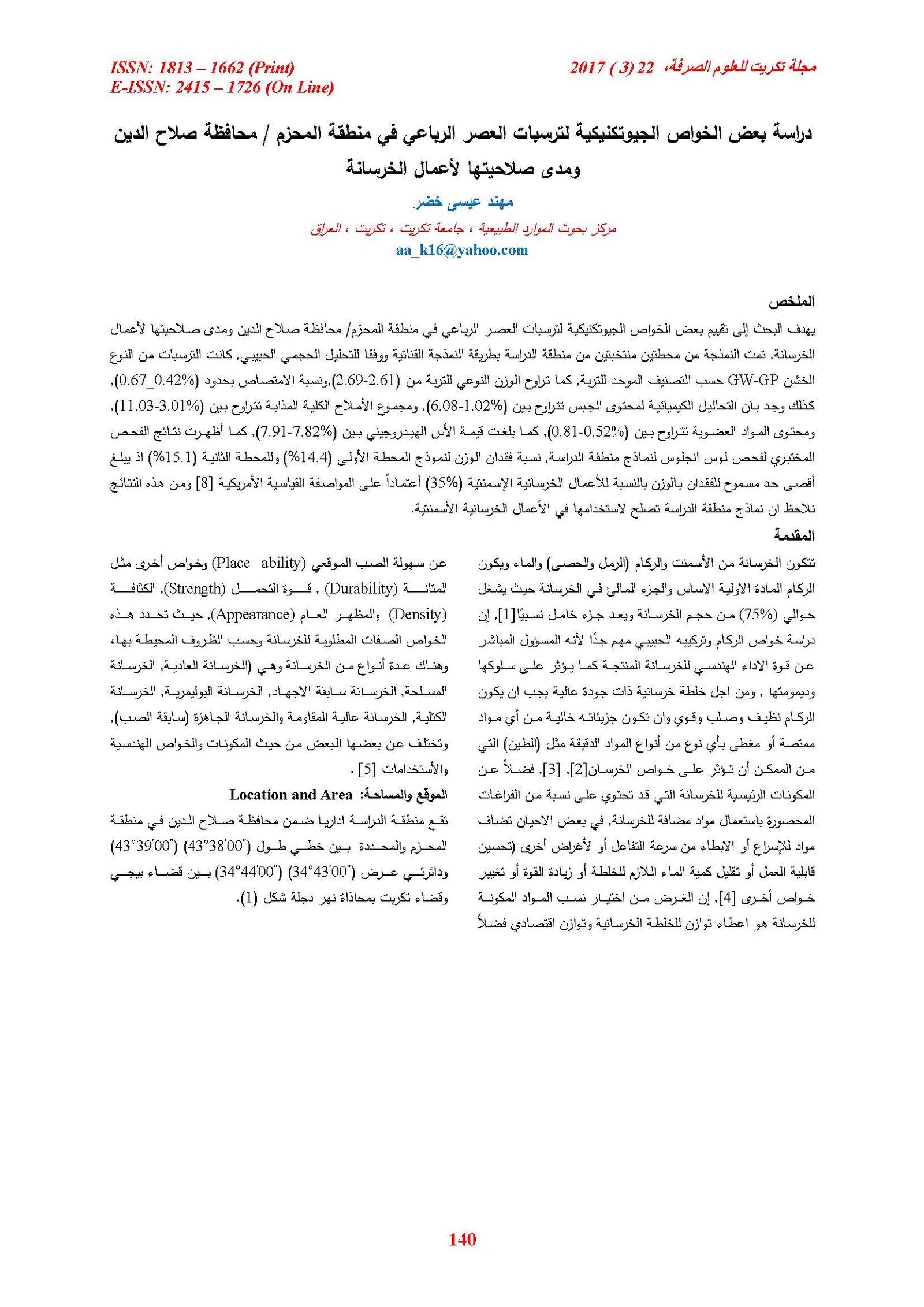A study Of Some Geotechnical Properties of Quaternary Deposits in AL_Mahzam Area Salahadden and its Suitability For Concrete Using
Main Article Content
Abstract
The aim of this research is to studying some geotechnical properties of Quaternary deposits in AL-Mahzam area /Salahaddin governorate and evaluate suitability of coarse soil for concrete samples have been collected from two stations using channel sampling and according to grain size analyses the type of soil is (GW-GP) according to unified soil classification and the values of specific gravity and absorption ratio ranges (2.61-6-08) (0.42-0.67)% respectively the chemical analysis for gypsum content , total dissolved salts, organic matters content and pH are (1.02-6.08) % (0.52- 11.03)% (0.52-0.81)% and (7.82-7.91)% respectively durability geotechnical test (loss Angeles) ranges between (14.4-15.1)% as a maximum limit allowed for the loss of weight for the cement concrete work (35%) depending on the American Standard [8] From these results we note that the study area models suitable for use in concrete works
Article Details

This work is licensed under a Creative Commons Attribution 4.0 International License.
Tikrit Journal of Pure Science is licensed under the Creative Commons Attribution 4.0 International License, which allows users to copy, create extracts, abstracts, and new works from the article, alter and revise the article, and make commercial use of the article (including reuse and/or resale of the article by commercial entities), provided the user gives appropriate credit (with a link to the formal publication through the relevant DOI), provides a link to the license, indicates if changes were made, and the licensor is not represented as endorsing the use made of the work. The authors hold the copyright for their published work on the Tikrit J. Pure Sci. website, while Tikrit J. Pure Sci. is responsible for appreciate citation of their work, which is released under CC-BY-4.0, enabling the unrestricted use, distribution, and reproduction of an article in any medium, provided that the original work is properly cited.
References
1. Neville, A.M, (1996) "Properties of Concrete", 4th Ed., Pitman Publishing Ltd., London
2. Neville, A.M., Brooks, J.J (2010): "Concrete Technology" ,2nd Edition, England, 442p
3. Bell, F.G.,(2007);- "Engineering Geology, 2nded., Butterworth Heinemann of Amsterdam, No.30, 582 p.
5. Shakhmenko, and Birsh,1998, Concrete Mix Design and optimization, 2nd Int. PhD. Symposium in Civil Engineering, Department of Building Materials., Riga Technical University, Budapest,.
6. Jassim, S.Z.(1981). Early Pleistocene gravel fan of the Tigris River from AL-Ftha to Baghdad, Central Iraq Jour. Geol. Scei Iraq,14,25-34
7. .Barzani, S.M., 2009, "Sediment Laboratory Tests For Geologist And Engineers", 1st Edition, Copenhagen, Pp-346.
8. ASTM, D422-63., (2004): Standard Test Method for Particle-Size Analysis of Soils.
9. ASTM- C,131,(2004). Standard Test Method For Sieve Analysis Of Fine And Coarse Aggregates,
11. B.S 882, (1992):- " Specification for aggregate from natural sources for concrete".
12. B.S 1377;1990: - "Method of determination of Organic Matter in aggregate"
13. Dunn, I., Anderson, L, kiefer, F. 1980, Fundamental of Geotechnical analysis, John wiely & sons inc., USA, 414 p. Edition, New York, John wiley and sons, Inc. London Engineering, vol. 1, 2nd ed., surrey university press, p252.
14. American Society for Testing and Materials (ASTM)C 131 –96(2004): "Standard Test Method for Resistance to Degradation of Small -Size Coarse Aggregate by Abrasion and Impact in the Los Angeles Machine", Volume 4, 1-4 p.
